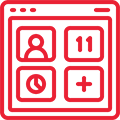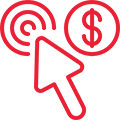“NEWMEDIA not only met, but greatly exceeded our goals for the project. They were incredibly responsive, quick to offer great solutions, and brought expertise we didn’t have. Their ability to think outside the box and create beautiful experiences for our customers is incredible.“
User experience UX design.
Trust NEWMEDIA.COM for Seamless Digital Experiences
Our UX design agency helps businesses build intuitive, user-focused digital products that keep visitors engaged and drive conversions. We combine user research, modern design principles, and data-driven insights to create interfaces that are simple, accessible, and easy to navigate.
From wireframing and prototyping to usability testing and optimization, we manage the entire UX process with a focus on performance and measurable results. Every design decision supports your business goals while improving the customer experience. The result is a product that looks great, works flawlessly, and delivers real value to both users and businesses.
Our UX Design Process
User Research and Competitor Analysis
We begin with in-depth user research and competitor analysis to uncover the best opportunities for intuitive design, seamless functionality, and strong user experiences. Our findings ensure every design decision aligns with business goals and user expectations for long-term success.
Goal-Focused UX Strategies
Each UX design project is tailored to your objectives, focusing on usability, accessibility, mobile responsiveness, and conversion-focused experiences. We align every step with measurable outcomes so your product supports growth and engagement.
Design, Prototyping, and Optimization
Our team manages the full UX design process, from wireframes and interactive prototypes to high-fidelity designs. We integrate user feedback, conduct usability testing, and refine interactions to create interfaces that are both functional and engaging.
Transparent Reporting and Insights
We provide detailed reports covering user behavior, engagement patterns, and conversion data. Our insights give you a clear view of how UX design impacts performance, helping you measure ROI and identify opportunities for ongoing improvement.
Case Studies
What’s Included in Our UX Design Services
User Research and Experience Mapping
We begin with in-depth user research to understand your audience’s needs, preferences, and pain points. With this data, we build user journeys and experience maps to guide design decisions so every interaction feels intuitive and user-centered.
Prototyping and Usability Testing
Our team creates wireframes and interactive prototypes to visualize the user experience early in the process. Usability testing helps identify friction points and allows us to refine designs for better engagement and smoother interactions.
Ongoing Support and Iteration
Our work does not stop at launch. We closely monitor user behavior and performance data to understand how people interact with your product. Our insights guide regular updates and design refinements, helping us remove friction points, improve navigation flows, and keep the experience aligned with your evolving business goals and user needs.
Content and Structure Planning
We organize content and navigation paths to create a logical site structure that supports both usability and conversion goals. Our planning ensures users can quickly find information while staying engaged throughout the experience.
Interface Design and Accessibility
We create interfaces that are both visually appealing and highly functional. Accessibility is a priority, so we follow best practices to ensure all users can easily navigate and interact with your product. Each design element, from color contrast to layout structure, is optimized for clarity, usability, and mobile readiness.
Performance Tracking & Reporting
We set up analytics to measure engagement levels, usability scores, and conversion data. Detailed reports connect our insights directly to design decisions, giving you a clear picture of how UX efforts improve user satisfaction and business outcomes over time.
See Our Portfolio
Molly Hall Dorais
Colorado Rocky Mountain School
Get a user-focused design strategy to increase engagement and conversions. Request your proposal for pricing and a growth plan.
Request A ProposalWhy Businesses Choose Our UX Design Agency
Companies choose our UX design agency for seamless, intuitive digital experiences. We use user research, modern design, and data-driven insights to create interfaces that engage visitors and drive meaningful actions.
Clients stay because our UX design delivers consistent results, clear reporting, and measurable improvements in engagement and conversions, letting them focus on growth while we handle the user experience.
What Customers Say About Us
Randall T.
Book a free consultation to plan a UX design strategy that drives engagement, conversions, and growth.
Book a free ConsultationRelated Services
Ask for a custom UX design proposal with a clear plan and transparent pricing crafted around your business goals.
Claim A Proposal










